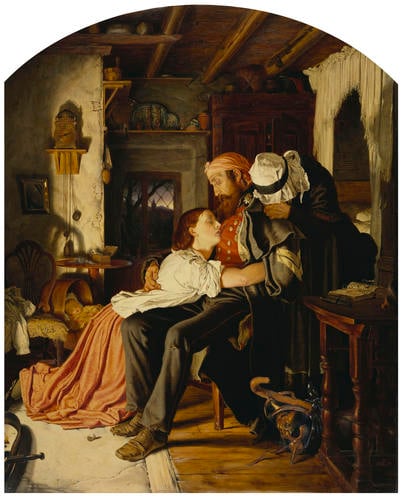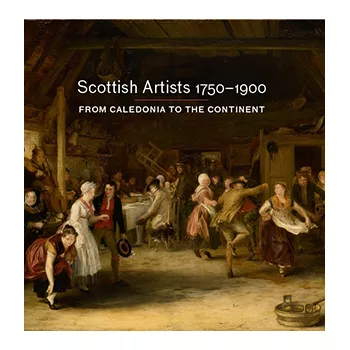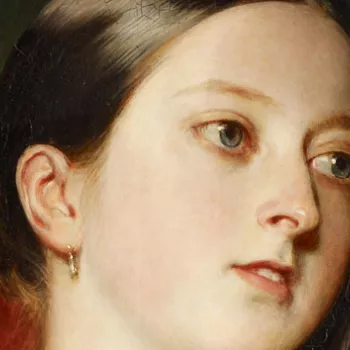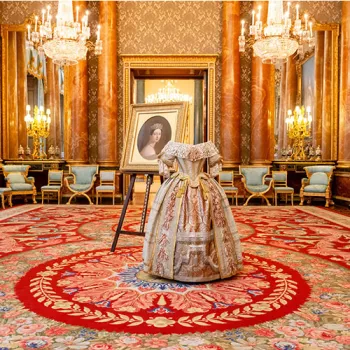Home (The Return from the Crimea) Signed and dated 1859
Oil on panel | 71.2 x 57.7 cm (support, canvas/panel/stretcher external) | RCIN 406954
-
A corporal in the Scots Fusilier Guards has arrived home in the early hours of the morning after completing a tour of service fighting in the Crimean War (March 1854 - Feburary 1856). His wife and mother put down their sewing and reading to embrace him as he collapses in a chair, exhausted and wounded. His head is bandaged and he has lost his left arm, just one of the many casualties of a 'modern' conflict which saw death and injury on all sides from both battle and disease. Souvenirs of war, including a Russian infantry helmet, folded letters on the table and a Crimean campaign medal, contrast with the innocent slumber of the child in the cot in the background, and with the reminders of peaceful pursuits: a fishing rod hangs from the rafters and a violin can be seen over the bed. While the mood is poignant, the underlying theme of Christianity as a source of strength and hope during times of hardship is symbolised by the open Bible, the glowing church seen through the window, and the composition itself, which in the arrangement of the three figures echoes that of a Lamentation, with Christ supported by Mary Magdalen and the Virgin Mary. The scene is dramatically lit by an unseen fire which the women have kept alight throughout the night to provide a welcome for their loved one.
The Scottish artist Noël Paton trained as a textile designer in Paisley and later enrolled at the Royal Academy Schools. He first exhibited a painting of this subject at the Academy in 1856 (Norfolk, VA, Chrysler Museum of Art). It was widely praised for its blend of emotional realism, patriotism and topical subject matter (peace having been achieved through the Treaty of Paris two months earlier). Lady Eastlake wrote, 'Paton's picture of a soldier, one-armed, footsore and ragged, returned home, and the mixed emotions of wife and mother is the picture: few came away from it with dry eyes. It is a superb thing' (Eastlake 1895, vol. II, p.84). Queen Victoria, who evidently was shown the painting in advance, was of the same mind: 'It is a good Exhibition this year, with many pretty pictures, the most striking amongst which being I think, Paton's Return of the Crimean Soldier, which we already saw at the Palace' (Journal, 1 May, 1856). She went on to note, 'it is beautiful in sentiment & execution, though perhaps a little wanting in colour', and when the royal couple commissioned this slightly smaller version, they made some suggestions for improving the colours and light. Paton agreed with the criticism and wrote that such changes '…would have been carried out on the present Picture had it been in my power to retain it but one day longer on my easel' (RA PPTO/QV/MAIN/1858/ 9946).
Queen Victoria and Prince Albert took a keen interest in the plight of British soldiers during the Crimean War. The Queen inspected regiments before their departure, signed the commission of every officer herself and awarded medals in person, placing particular emphasis on their quick distribution. She also offered pensions for those who, like Paton's corporal, lost limbs in battle. Another, Sergeant Breese of the 11th Hussars, was sketched by the Queen who also commissioned a photograph of him (RCIN 2500154). He was later appointed a Yeoman of the Guard with a pension for life.
Text adapted from 'Victoria and Albert: Art & Love', London, 2010Provenance
Commissioned by Queen Victoria (1819-901) (£400, payment dated 16 March 1860, QV Ledgers 1860/471); given to Prince Albert by Queen Victoria on24th December 1859 [Victoria & Albert: Art & Love, London, 2010, pg 462]
-
Creator(s)
Acquirer(s)
-
Medium and techniques
Oil on panel
Measurements
71.2 x 57.7 cm (support, canvas/panel/stretcher external)
101.9 x 89.0 x 6.1 cm (frame, external)
Category
Object type(s)
Other number(s)
Alternative title(s)
The Soldier's Return












